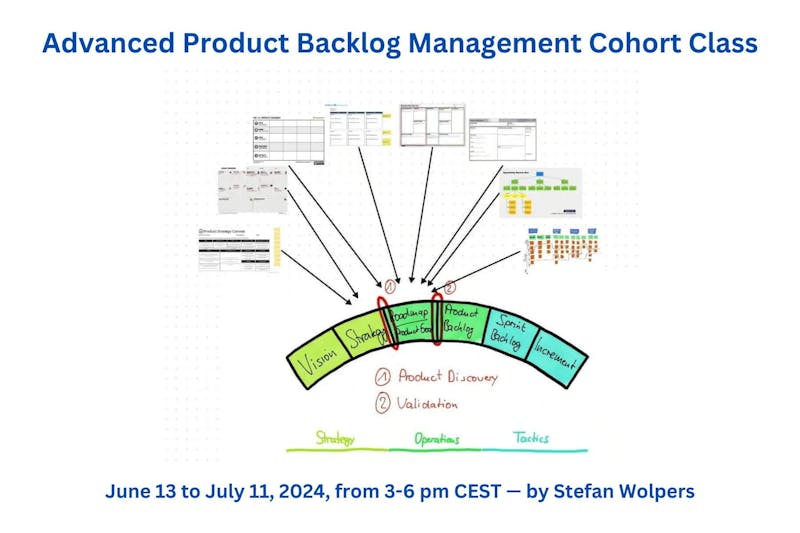|
Are you struggling with imposter syndrome as a new Scrum Master? Then avoid five common rookie mistakes Scrum Masters make. Instead, discover how to set clear Sprint Goals, build trust, balance metrics, and empower your team to make independent decisions. (Read online.)
Don’t let early missteps define your journey. Learn from these mistakes and transform them into stepping stones towards mastery. By understanding and addressing these pitfalls, you’ll gain confidence, enhance your leadership skills, and truly embody the principles of Scrum.
This article provides actionable insights and practical exercises to help you grow from a beginner into an effective and respected Scrum Master.


🎓 Launch on July 1, 2024: Learn How to Master the Most Important Artifact in the Advanced Product Backlog Management Course!
👉 Please note:
- The course includes membership in a new community of agile professionals.
- Become fully reimbursed if you also choose to join the Advanced Product Backlog Management Cohort of June 13 - July 11, 2024, at € 399.
- The course will only be available until July 8, 2024, for sign-up!
Rookie Mistakes Scrum Master Make
Let us delve into the rookie mistakes Scrum Masters make:
1. Ignoring the Importance of the Sprint Goal
-
Mistake: Treating the Sprint Goal as optional or just a list of tasks, leading to a lack of focus and direction for the Scrum Team.
-
Why it’s a Mistake: The team lacks a unified purpose without a clear Sprint Goal, resulting in fragmented efforts, reduced overall value delivery, and difficulty measuring success. The team may become directionless, working on tasks that don’t align with the Product Goal or the strategic objectives of the product generally.
-
Learning Opportunity: Legitimate beginners quickly realize the importance of a well-defined Sprint Goal as a beacon guiding the team’s efforts. It fosters collaboration and ensures that the team delivers meaningful value each Sprint. To practice this, try a Sprint Goal workshop before the next Sprint, where the team collaborates to draft a clear, cohesive goal. Learn more about them with Maarten Dalmijn’s fantastic book on Sprint Goals. [Amazon Affiliate Link.]
2. Micromanaging the Team
-
Mistake: Acting as a task or project manager, constantly overseeing and directing the work of the Developers.
-
Why it’s a Mistake: Scrum Masters should serve the team by removing impediments and facilitating processes, not controlling the work as the Developers have agency doing their part. Micromanagement stifles team autonomy and innovation, leading to reduced morale and a lack of ownership among team members, ultimately hampers productivity and creativity.
-
Learning Opportunity: True beginners learn to trust their team’s capabilities, focusing instead on enabling the team to self-organize and resolve issues independently, leading to higher engagement and better problem-solving. An exercise to help with this is to restrain from solving issues during a Sprint but observe and support their teammates’ progress.
3. Neglecting to Build Team Trust and Psychological Safety
-
Mistake: Failing to create an environment of trust and psychological safety where all team members feel comfortable sharing ideas and concerns.
-
Why it’s a Mistake: Without trust and safety, team members are less likely to engage fully, collaborate effectively, or take risks. Neglecting trust stifles innovation and continuous improvement, leading to a work environment with undisclosed problems, lackluster team engagement, and restrained creativity. It can also result in high turnover and low job satisfaction.
-
Learning Opportunity: Proficient Scrum Masters actively work to build and maintain a culture of trust and psychological safety. They encourage open communication and constructive feedback. A practical exercise is to hold regular team-building activities and trust exercises, such as sharing personal success stories, challenges, and failures to build empathy and understanding among team members.
4. Focusing Solely on Metrics and Reporting
-
Mistake: Overemphasizing metrics, OKRs, and KPIs, turning the Scrum Master role into a data-entry clerk burdened with excessive reporting.
-
Why it’s a Mistake: While metrics can provide valuable insights, overemphasis can distract from the true purpose of Scrum, which is delivering value through collaborative efforts and continuous feedback based on frequent releases and an empirical process. A metrics-driven approach can also lead to gaming the system, where team members focus on meeting the metrics rather than creating genuine value, thus distorting the team’s priorities.
-
Learning Opportunity: Effective Scrum Masters balance metrics with qualitative insights, using them to support, not dictate, team decisions and progress. They understand that metrics are tools, not goals in themselves. An exercise to implement this is to periodically review the metrics with the team, discussing their relevance and how they align with actual value delivery, ensuring a balanced approach.
5. Failing to Empower the Team
-
Mistake: Not empowering the team to make decisions and solve problems, often stepping in to make decisions or resolve conflicts.
-
Why it’s a Mistake: This approach undermines the team’s confidence and ability to self-manage, leading to dependency on the Scrum Master and reduced team ownership of the work. It hampers the team’s growth, creativity, and innovation ability, as members are not encouraged to think independently or take initiative.
-
Learning Opportunity: Good Scrum Masters learn to step back and facilitate the team’s decision-making processes, encouraging team members to take ownership of their work and develop their problem-solving skills. A helpful exercise is to use a decision matrix, for example, based on the outcome of a Delegation Poker session, where the team collaboratively decides on solutions to issues without direct intervention from the Scrum Master, promoting autonomy and confidence.
🎓 🖥 💯 🇬🇧 Advanced Product Backlog Management Cohort Class of June 13-July 11, 2024
Discover the Product Owner success principles in this guaranteed engaging Product Backlog Management cohort class and accelerate your professional growth and career perspective with tried & tested, hands-on practices:
- Excel at delivering value regularly — your #1 career success factor.
- Learn to distinguish between valuable and useless ideas.
- Abandon the feature factory. Instead, learn to contribute to customer and organizational success.
- Gain actionable insights, learn supportive tools, and practice everything in a safe community of like-minded peers.
- Learn to say no and build trust and rapport with stakeholders while focusing on creating value.
- Create engaging feedback loops.
Additional bonuses:
- You will become a member of an exclusive community of product professionals comprising participants from all my classes since 2019.
- You will have free access to the corresponding online course; revisit all topics of the cohort at your convenience.
Quote: “If you are looking to move beyond merely delivering features and want to start consistently delivering outcomes and valuable deliverables to your customers, this course is essential. Stefan provides the focus and tools necessary to embark on a journey toward excellent product management. With a curriculum that includes vision, strategy, roadmap, product discovery, continuous delivery, idea management, hypothesis management, and backlog management, this course promises less than it delivers—a truly transformative experience.” (Hector Feliciano.)
Enjoy the benefits of an immersive cohort class and its community with like-minded agile peers on Juni 13, June 27, and July 11, 2024, from 3-6 pm CEST. The class will be offered in English.

👉 Join now: 🖥 💯 🇬🇧 Product Backlog Management Class of Juni 13-July 11, 2024.
Useful Practices for Beginners to Avoid Rookie Mistakes Scrum Masters Make
Some food for thought for the aspiring learner: there is no need for you to reinvent the wheel:
Embrace Continuous Learning: Scrum Masters should always be on a path of continuous learning. Scrum and agile practices evolve, and so should your understanding and application of them. Seek opportunities for training, certifications, and networking with other Scrum professionals. For example, join the Hands-on Agile Slack community or our Meetup group.
Understand the Organizational Context: Every organization has its unique culture and challenges. Understanding the broader context within which your team operates can help you better support and advocate for Scrum practices. Engage with stakeholders and management to align Scrum with organizational goals. Remember, you cannot change a system at the Scrum team level.
Balance Empathy with Accountability: Building a high-performing team requires a delicate balance of empathy and accountability. While fostering a supportive environment is crucial, holding the team accountable to commitments and quality standards is equally important. Great Scrum teams hold themselves accountable all the time; they are professionals.
Be a Servant Leader: As a Scrum Master, your primary role is to serve the team, for example, by removing impediments, facilitating communication, and supporting the team’s self-organization. The team’s success measures your success, so focus on empowering them.
Adaptability is Key: No two teams are the same, and what works for one might not work for another. Be flexible and willing to adapt your approach based on the team’s needs and feedback. Continuously inspect and adapt not just the team’s processes but your own practices and mindset.
Foster a Growth Mindset: Encourage a culture where failure is seen as an opportunity to learn and grow. Coupled with a growth mindset, it can significantly enhance the team’s ability to innovate and improve continuously. Celebrate successes but also openly discuss failures and the lessons learned from them.
Value Feedback Loops: Feedback is the cornerstone of continuous improvement. Make sure your team regularly seeks and gives feedback, not just during formal events like Sprint Reviews and Retrospectives but also in daily interactions. Feedback taken seriously will help identify issues early and promote a culture of transparency and improvement.
Conclusion
The critical difference between the rookie mistakes of the ignorant imposter and the actions of a learning beginner is the willingness to reflect, adapt, and grow from experiences. Self-proclaimed experts who misunderstand and, consequently, misapply the principles of Scrum fail to recognize and rectify their mistakes. At the same time, true beginners use these early missteps as stepping stones toward becoming effective and respected Scrum Masters.
Recommended Reading Rookie Mistakes Scrum Masters Make
Scrum Master Anti-Patterns — 20 Signs Your Scrum Master Needs Help.
83 Scrum Master Interview Questions to Identify Suitable Candidates.
Peer Recruiting: How to Hire a Scrum Master in Agile Times.
Download the Scrum Anti-Patterns Guide for free.
📅 Training Classes, Meetups & Events
Upcoming classes and events:
See all upcoming classes here.

If you have friends or colleagues who might be interested in this article as well, please forward this email—it would mean the world to me!
Have a great day!
Best,
|

